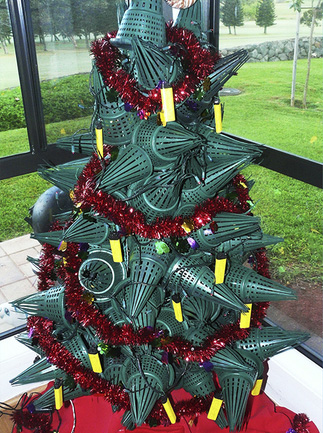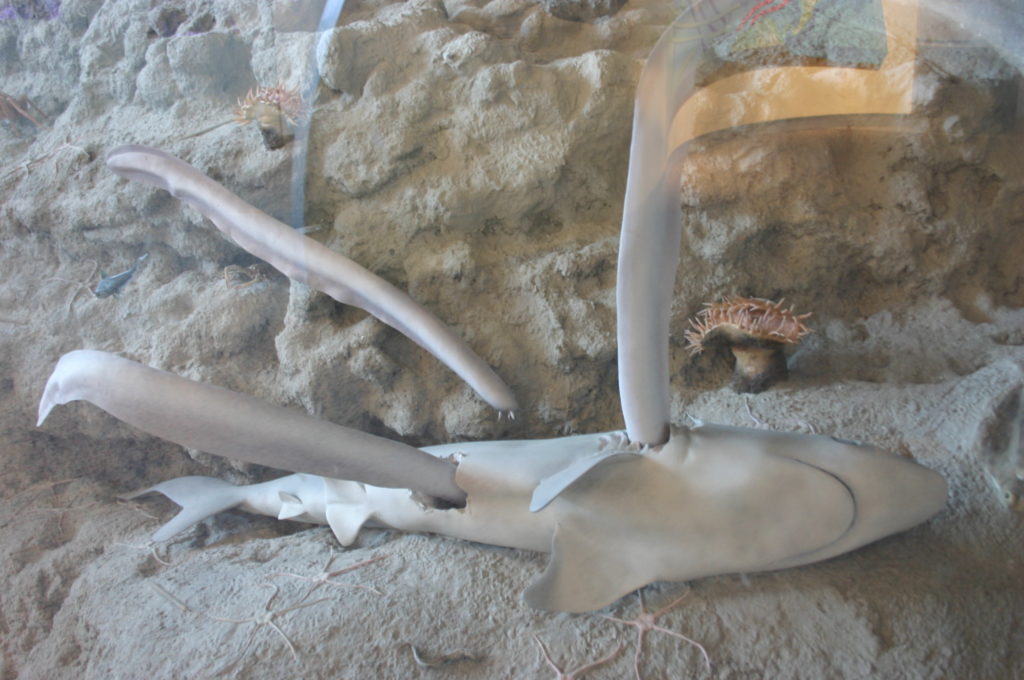Published in the Ocean Watch column, Honolulu Star-Advertiser © Susan Scott
January 21, 2017
Hagfish get no respect. And they should. The eel-shaped, bottom-dwelling creatures, averaging 20 inches long, provide humans with food, clothing, wallets, a crackerjack recycling system and snot. Not many fish are so giving.
Hagfish are best known for producing great gobs of clingy mucus that reminds nearly everyone, including workers at Scripps Institute of Oceanography, of snot (goo.gl/VxDz1L).
 Susan Scott’s Christmas tree was made of painted hagfish traps,
Susan Scott’s Christmas tree was made of painted hagfish traps,
which frequently wash ashore in Hawaii.
©2017 Susan Scott
Hagfishes’ copious slime, however, isn’t just for grossing people out. It frustrates predators. Deepwater videos show that when a shark or grouper bites a hagfish, it secretes a cloud of mucus. Because fish breathe by taking water in the mouth and out the gills, the slime clogs the gills, choking the attacker: goo.gl/Yn9Apt.
Because hagfish are blind, however, they don’t see the shark coming, and it has its teeth in the hagfish’s skin before the slime fills its gills.
But hagfish live inside a bag of loose skin, which attaches to the body in one line down the creature’s back, and in flexible connections to the mucus glands. If shark teeth puncture the skin, they don’t get the muscle beneath. Since hagfish have low blood pressure, skin bites bleed minimally and don’t appear to slow the fish down.
Baggy skin also helps hagfish, using body contortions, to squeeze through openings half the size of its diameter. This is essential because the bottom-dwelling fish wiggle into the eyes, gills and anuses of dead whales, seals and fish, eating from the inside out.
 Jawless Hagfish,
Jawless Hagfish,
Courtesy Ryan Somma, Flickr. Creative Commons 2.0.
To help push itself into a puka and wipe slime off its body, a hagfish ties itself in a moving knot. If goo fills its one nostril, the fish sneezes.
Hagfish slime could save us from polyester. Its protein threads are strong as spider silk, meaning it might be a natural and renewable alternative to synthetic fibers, such as nylon and spandex, made from petroleum.
The West Coast has an active hagfish fishery. The main marketplace is Korea, where people eat them and use the skin for so-called eel-skin wallets and purses.
You might think you don’t know hagfish traps, but all Hawaii’s beachgoers do. They’re those black plastic cones with frills that come to a point. Fishers fasten these to a hole in a closed, baited bucket. The fish swim in but can’t get out. Endless numbers of these floating traps come loose from their buckets and end up on Hawaii’s beaches.
Hagfish were a frequent topic of discussion at my house recently. We had several guests over the holidays who all wondered what was up with my weird Christmas tree. It’s made of washed and painted hagfish traps.